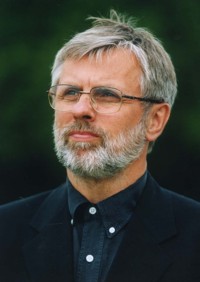| A | B | C | D | E | F | G | H | I | J | K | L | Ł | M | N | O | P | R | S | T | U | W | Z |
 Eugeniusz Knapik,
Eugeniusz Knapik,
Polish composer and pianist, b. 9th July 1951 in Ruda Śląska. In 1970-76, he studied composition with Henryk Mikołaj Górecki and piano with Czesław Stańczyk at the State Higher School of Music in Katowice (now the Music Academy). In 1976, he received a French government scholarship to study composition with Olivier Messiaen in Paris. At present he holds the post of professor at the Department of Composition, Conducting and Music Theory at the Music Academy in Katowice. He is the founder and director (since 1992) of the Computer and Electroacoustic Music Studio at that academy. As a pianist, he gives performances in Poland and abroad, playing mostly 20th century piano works. He has widely recorded for the radio and television as well as record companies. worksEugeniusz Knapik made his debut as a composer with Andrzej Krzanowski and Aleksander Lasoń at the "Young Composers for the Young City" festivals in Stalowa Wola, where in 1975-80, eleven works by these three composers (named "Generation '51" because of their dates of birth) were performed for the first time. Eugeniusz Knapik had two of his compositions premiered in Stalowa Wola: Tak jak nad brzegiem morza [As on the Seashore] for instrumental ensemble and tape (1977) and Corale, interludio e aria for flute, harpsichord and eleven string instruments (1979). The composer defined the principles of the Stalowa Wola group in these words: "The work of the composers who entered their artistic lives at the fesivals in Stalowa Wola was a kind of opposition to the 1950s and 60s avant-garde: opposition towards novelty for novelty's sake, and towards total destruction. This opposition was a spontaneous, intuitive, deep-rooted reaction, which we only later became fully aware of." |
kompozycje
Three Miniatures for Piano (1970)
Sonata for Violin and Piano * (1971)
Sonata for solo flute * (1972)
Concerto grosso no. 1 for chamber orchestra (1972-77)
La Flute de jade for soprano and orchestra to words by Chinese poets * (1973)
Psalms for solo voices, mixed choir and great symphony orchestra (1973-75)
Le Chant for soprano and orchestra to texts by Paul Valéry * (1976)
Tak jak na brzegu morza... for instrumental ensemble and tape to a text by Paul Valéry * (1977)
Corale, interludio e aria for flute, harpsichord and string ensemble * (1978)
String Quartet * (1980)
Partita for violin and piano * (1980)
Hymn for clarinet, trombone, cello and piano * (1982)
Versus I for organ * (1982)
Islands for chamber string orchestra * (1983-84)
Strophes for baritone, horn and organ (1984-85)
Das Glas im Kopf wird vom Glas, opera in 8 scenes to a libretto by Jan Fabre - Part 1 of an opera trilogy The Minds of Helena Troubleyn (1987-89)
Silent Screams, Difficult Dreams, opera in 4 scenes - Part 2 of an opera trilogy The Minds of Helena Troubleyn (1990-92)
The Sound of One Hand Clapping, ballet to a libretto by Jan Fabre (1991)
Da un'altra faccia del tempo, ballet to a libretto by Jan Fabre (1993)
La liberta chiama la liberta, opera in 5 scenes - Part 3 of an opera trilogy The Minds of Helena Troubleyn * (1993-95)
Quando la terra si rimette in movimento, ballet to a libretto by Jan Fabre (1995)
Three Solos, ballet to a libretto by Jan Fabre (1995)
Up Into the Silence, songs for soprano, baritone, string ensemble and orchestra to words by Edward E. Cummings and Jan Fabre * (1996-2000)
Tha' Munnot Waste No Time for three (or two) pianos and clarinet (1998)
I'm Coming Near You for soprano and chamber orchestra to words by Edward Stachura (2001)
|
literatura wybrana
Baculewski Krzysztof Knapik Eugeniusz In: Encyklopedia Muzyczna PWM (część biograficzna pod red. Elżbiety Dziębowskiej) [The PWM Encyclopaedia of Music - biographical part, ed. by Elżbieta Dziębowska], vol. "klł", PWM, Kraków 1997
Bias Iwona Eugeniusz Knapik. Kompozytor i pianista [Eugeniusz Knapik. The Composer and the Pianist.], Akademia Muzyczna w Katowicach, Katowice 2001
Kosz Stanisław Eugeniusz Knapik - "Wyspy" [Eugeniusz Knapik - "Islands"] In: Muzyka polska 1945-1995 [Polish Music 1945-1995] (ed. by Krzysztof Droba, Teresa Malecka, Krzysztof Szwajgier), Akademia Muzyczna w Krakowie, Kraków 1996
Thomas Adrian Knapik Eugeniusz In: The New Grove Dictionary of Music and Musicians. Second Edition (ed. Stanley Sadie), vol. 13, Macmillan Publishers Limited, London 2001
|

|